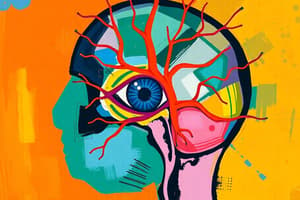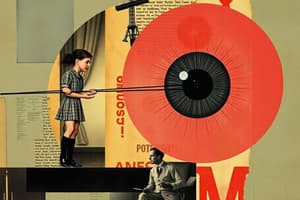Podcast
Questions and Answers
What is the primary motor function of the trigeminal nerve?
What is the primary motor function of the trigeminal nerve?
- Facial expression
- Vision
- Facial sensation
- Mastication (correct)
Which of the following evaluations would NOT typically be included in assessing the sensory function of the trigeminal nerve?
Which of the following evaluations would NOT typically be included in assessing the sensory function of the trigeminal nerve?
- Taste tests on the anterior tongue (correct)
- Corneal reflex test
- Sharp and dull sensation tests
- Touch sensitivity in nerve distribution
Which sign is indicative of an upper motor neuron lesion when assessing the facial nerve function?
Which sign is indicative of an upper motor neuron lesion when assessing the facial nerve function?
- Inability to close the eyes tight
- Incomplete corneal reflex
- Forehead sparing (correct)
- Asymmetrical strength in mastication
What is the result of Weber’s test in a case of sensorineural hearing loss?
What is the result of Weber’s test in a case of sensorineural hearing loss?
When assessing the corneal reflex, what is the expected response?
When assessing the corneal reflex, what is the expected response?
What is a common symptom of Bell’s Palsy affecting facial nerve function?
What is a common symptom of Bell’s Palsy affecting facial nerve function?
Which testing method can help assess auditory acuity for the vestibulocochlear nerve?
Which testing method can help assess auditory acuity for the vestibulocochlear nerve?
Which of the following assessments is NOT directly related to motor function in cranial nerve evaluation?
Which of the following assessments is NOT directly related to motor function in cranial nerve evaluation?
Which finding would you expect in a patient with a lower motor neuron lesion of the facial nerve?
Which finding would you expect in a patient with a lower motor neuron lesion of the facial nerve?
What is the primary role of the motor component of the trigeminal nerve?
What is the primary role of the motor component of the trigeminal nerve?
What is the primary function of the trochlear nerve?
What is the primary function of the trochlear nerve?
Which statement accurately describes the role of the abducens nerve?
Which statement accurately describes the role of the abducens nerve?
During a neurologic assessment, which of the following tests assesses the function of the trigeminal nerve?
During a neurologic assessment, which of the following tests assesses the function of the trigeminal nerve?
What clinical sign might indicate combined cranial nerve lesions involving the hypoglossal nerve?
What clinical sign might indicate combined cranial nerve lesions involving the hypoglossal nerve?
Which test would evaluate the integrity of the facial nerve?
Which test would evaluate the integrity of the facial nerve?
Which clinical finding is likely if there is a lesion in the glossopharyngeal nerve?
Which clinical finding is likely if there is a lesion in the glossopharyngeal nerve?
When testing the accessory nerve, which of the following movements should be assessed?
When testing the accessory nerve, which of the following movements should be assessed?
How can a clinical examination indicate a lesion in the vagus nerve?
How can a clinical examination indicate a lesion in the vagus nerve?
Which of the following assessments is used to evaluate the function of the hypoglossal nerve?
Which of the following assessments is used to evaluate the function of the hypoglossal nerve?
What is the primary function of the trochlear nerve (IV)?
What is the primary function of the trochlear nerve (IV)?
What is the main role of the abducens nerve (VI)?
What is the main role of the abducens nerve (VI)?
Which statement accurately describes the trigeminal nerve (V)?
Which statement accurately describes the trigeminal nerve (V)?
What is a common cause for lesions affecting cranial nerves III, IV, and VI simultaneously?
What is a common cause for lesions affecting cranial nerves III, IV, and VI simultaneously?
Which of the following assessments is primarily associated with the functioning of the facial nerve?
Which of the following assessments is primarily associated with the functioning of the facial nerve?
In cases of trochlear nerve (IV) lesions, which of the following symptoms would most likely be present?
In cases of trochlear nerve (IV) lesions, which of the following symptoms would most likely be present?
Which condition is least likely to cause combined lesions of cranial nerves III, IV, and VI?
Which condition is least likely to cause combined lesions of cranial nerves III, IV, and VI?
How does the trigeminal nerve primarily assess sensory perception?
How does the trigeminal nerve primarily assess sensory perception?
What unique feature distinguishes the trochlear nerve from other cranial nerves?
What unique feature distinguishes the trochlear nerve from other cranial nerves?
Flashcards
Trigeminal nerve function
Trigeminal nerve function
The primary motor function is mastication (chewing).
Trigeminal sensory assessment
Trigeminal sensory assessment
Facial sensation tests, not taste on anterior tongue.
Upper motor neuron facial nerve lesion
Upper motor neuron facial nerve lesion
Forehead sparing is a key sign.
Weber's test in sensorineural hearing loss
Weber's test in sensorineural hearing loss
Signup and view all the flashcards
Corneal reflex
Corneal reflex
Signup and view all the flashcards
Bell's Palsy symptom
Bell's Palsy symptom
Signup and view all the flashcards
Auditory acuity assessment
Auditory acuity assessment
Signup and view all the flashcards
Non-motor cranial nerve assessment
Non-motor cranial nerve assessment
Signup and view all the flashcards
Lower motor neuron facial nerve lesion
Lower motor neuron facial nerve lesion
Signup and view all the flashcards
Trigeminal motor function
Trigeminal motor function
Signup and view all the flashcards
Trochlear nerve function
Trochlear nerve function
Signup and view all the flashcards
Abducens nerve function
Abducens nerve function
Signup and view all the flashcards
Trigeminal nerve assessment
Trigeminal nerve assessment
Signup and view all the flashcards
Hypoglossal nerve lesion sign
Hypoglossal nerve lesion sign
Signup and view all the flashcards
Facial nerve assessment test
Facial nerve assessment test
Signup and view all the flashcards
Glossopharyngeal nerve lesion symptom
Glossopharyngeal nerve lesion symptom
Signup and view all the flashcards
Accessory nerve assessment
Accessory nerve assessment
Signup and view all the flashcards
Vagus nerve lesion indication
Vagus nerve lesion indication
Signup and view all the flashcards
Hypoglossal nerve assessment
Hypoglossal nerve assessment
Signup and view all the flashcards
Trochlear nerve (IV) function
Trochlear nerve (IV) function
Signup and view all the flashcards
Abducens nerve (VI) function
Abducens nerve (VI) function
Signup and view all the flashcards
Trigeminal nerve (V) function
Trigeminal nerve (V) function
Signup and view all the flashcards
Cranial nerve III, IV, VI lesion cause
Cranial nerve III, IV, VI lesion cause
Signup and view all the flashcards
Facial nerve assessment
Facial nerve assessment
Signup and view all the flashcards
Study Notes
Cranial Nerves III, IV, VI - Oculomotor, Trochlear, Abducens
- Cranial Nerves III, IV and VI all have a role in eye movement and innervate the extrinsic muscles of the eye.
- Cranial Nerve III (Oculomotor) - Innervates extrinsic eye muscles, raises eyelid, and controls intrinsic eye muscles for pupillary constriction and accommodation.
- Cranial nerve IV (Trochlear) - Innervates the superior oblique muscle for lateral and inferior gaze.
- Cranial nerve VI (Abducens) - Innervates the lateral rectus muscle for outward (lateral) gaze.
- A single lesion of cranial nerve IV is rare, common cause is trauma to the orbit.
- Signs of a single cranial IV lesion are:
- Diplopia due to weakness and downward and inward eye movement
- The patient will compensate by tilting their head away from the affected side to avoid this
- Signs of a single cranial VI lesion are:
- Inability to look laterally
- Causes of cranial VI lesions are:
- Multiple Sclerosis (MS)
- Pontine Cerebrovascular Accident (CVA)
- A collective lesion of cranial nerves III, IV, VI can be caused by:
- Cerebrovascular Accident (CVA)
- Tumours
- Wernicke's encephalopathy
- Aneurysms
- Multiple Sclerosis (MS)
- Myasthenia gravis
- Meningitis
- Muscular dystrophy
- Myotonic dystrophy
- Cavernous sinus thrombosis
- Guillain-Barré Syndrome (GBS)
- Cranial arteritis
- Trauma
- Orbital pathology
- Cranial III palsy is uncommon.
- Mortality and morbidity depends on the underlying cause.
- Underlying causes of cranial nerve III palsy:
- Subarachnoid haemorrhage
- Meningitis
- Neoplasm
- Other potential causes of cranial nerve III palsy:
- Direct trauma
- Demyelinating disease (ie MS)
- Increased intracranial pressure
- Space-occupying lesion
- Spontaneous subarachnoid haemorrhage
- Microvascular disease (ie diabetes)
- Microvascular disease (ie giant cell arteritis)
Studying That Suits You
Use AI to generate personalized quizzes and flashcards to suit your learning preferences.




